-
Posts
2,694 -
Joined
Content Type
Profiles
Forums
Gallery
Events
Articles
Posts posted by constanius
-
-
-
There can be no doubt that the reverse is by Kettle.
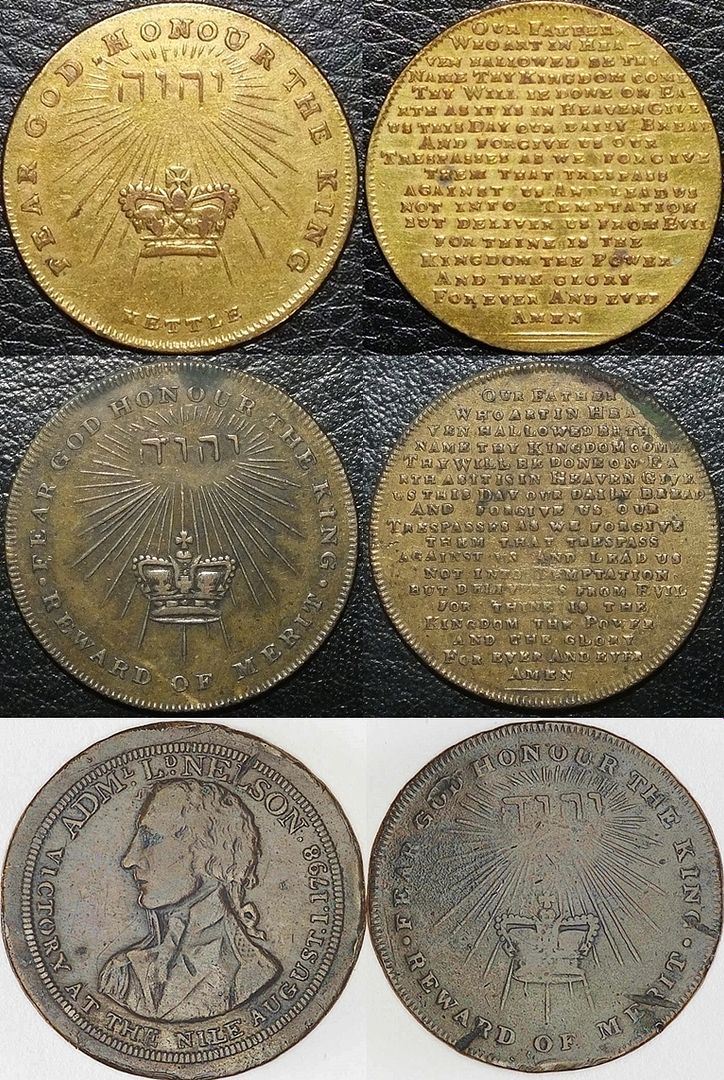
James Conder did not list this and all the other authors are much later. Why the attribution to Kempson is very strange, though there has been some confusion over K & S, whether it stands for Kempson & Son or Kettle & Son(s).
Just because the obverse is dated 1798 does not necessarily mean that was when in was struck, it could in fact have been struck later. There are 2 scenarios that I can think of,
1) The establishment at Portsmouth of the first School of Naval Architecture. This school was opened at the commencement of 1811, and was conceived in the grandest spirit, at least so far as the building was concerned, for over 30,000 GBPs. are said to have been expended on its erection.
The school thus founded remained in operation for more than twenty years, but only trained about forty students. It was intended exclusively for the education of a higher class of apprentices, who were guaranteed appointments to important offices in the Royal Dockyards on the satisfactory completion of their course: and it was an experiment in a direction which has always found favour with many persons who consider it preferable to provide candidates for the higher professional offices from the better-placed and more liberally-educated classes.Could this be a reward of merit for the Academy?2) My choice is this........ In Birmingham, is the very first statue of Horatio Nelson in Britain. It was proposed 1805 and made 1807-1809 by public subscription of £2,500 by the people of Birmingham. The statue was unveiled on 25 October 1809, that being the day decreed as the official golden jubilee of George III. Nelson had visited Birmingham in 1802 to great rejoicing over his victory at the Battle of the Nile.
Nelson, bare headed, stands in uniform, with his one arm resting on an anchor with the prow of a miniature ship: HMS Victory. Upon the ship is the Flag Staff Truck (part of the mast) of the French ship Orient (1791), flagship of the French fleet, sunk at the Battle of the Nile.Here is a Birmingham Work House token shilling, which could have been issued to celebrate the King's Jubilee and the unveiling of the "Nile Victory" statue. It is possible that Kettle was the engraver, the inscription compares favourably with his from that period. So the tokens that BHM dates for the King's demise, could have been as, Fauver states, for the Jubilee.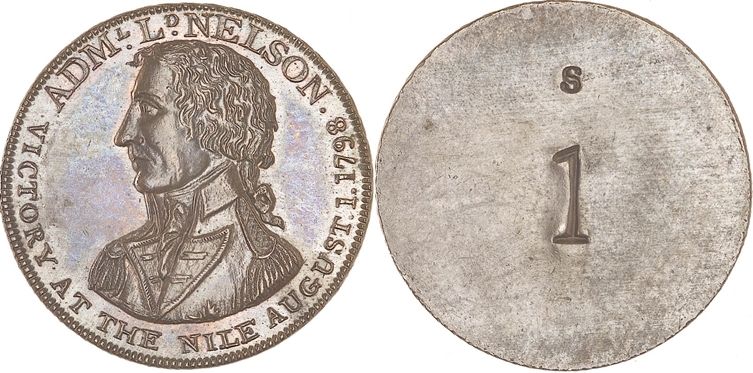 Compare the lettering on these two, so unless there is documented proof that it is by Kempson I am sticking with Kettle.
Compare the lettering on these two, so unless there is documented proof that it is by Kempson I am sticking with Kettle.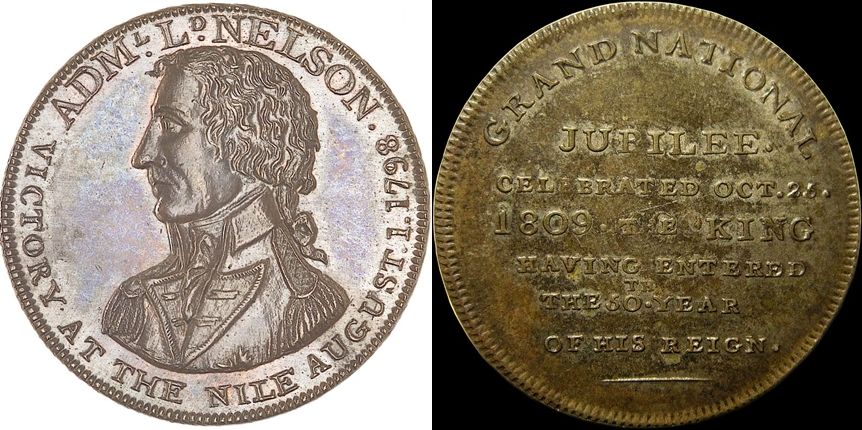 Here is an account from 1809,"Birmingham.—The morning was ushered in with the ringing of bells, and the shops were mostly shut throughout the town. A very general attendance took place at the different churches and chapels, and other places of worship, at the .doors of which the sum of ,£310. 3s. Id. was collected for the benefit of the podr; in addition to which, the Right Hon. Lord Dudley and Ward, with his usual liberality, presented £'25. and Heneage Legge, Esq. ,£10. After service the 4th Dragoon Guards fired three volleys in honour of the day, as did also the Handsworth Volunteer Cavalry, drawn up in the Market Place.—At three o'clock commenced the Druids' Procession, consisting of nearly 1400 members, from Lodges 17, 31, and 32, of the town, and No. 40, from Walsall, which was attended by a vast concourse of people. After proceeding round the Statue of Nelson, they attended divine service at St. Philip's Church, where an excellent and appropriate sermon was delivered by Dr. L. Booker, from the following text, 1 Pet. 2 c. 9th and 17th v. The festival was commemorated in the evening, by different dinner parties at most of the inns and public places in the town. Edward Cairns, Esq. the Low Bailiff, gave a sumptuous entertainment at the Shakspeare Tavern; amongst whom were the Members for the County, the Magistrates, Clergy, &c. &c. It is unnecessary to add that the evening was spent in the greatest loyalty and good humour.— A circumstance which added not a little to the pleasure of the day, and the beauty of the scene, was the opening to public view the celebrated Bronze Statue of the ever to be lamented hero, Viscount Nelson. Every thing was ready for submitting this statue to public inspection on the 21st, the anniversary of the glorious victory of Trafalgar, but the Committee properly conceived that it would be better to defer the eeremony till the anniversary of his Majesty's accession, in order to heighten the joy of the public, on an event so interesting to the nation. At twelve o'clock at night, on the 24th, the signal for opening the statue was given, to usher in the morning of our good King's fiftieth anniversary, and such a scene of popular eagerness was hardly ever witnessed before. Peace officers were stationed to protect the workmen, until the awnings of the scaffold immediately connected with the monument were removed, but this business was hardly a moment over, when the populace broke down every impediment, and not fewer than 5000 people present immediately gave three cheers for Nelson, and joining a fine band of music who attended on the occasion, sung "God save the King." The loyal enthusiasm of the people was not surpassed in any part of the Empire. The Local Militia, in the course of the day, formed round the statue, and fired a feu de joie. The whole of the day was marked by patriotic festivity.—The following illustration of the statue was given to the public, and it is admitted that the artist, Mr. Westmacott, has fully supported his high reputation by this work, and that it is in all respects worthy of the dignified and impressive subject.
Here is an account from 1809,"Birmingham.—The morning was ushered in with the ringing of bells, and the shops were mostly shut throughout the town. A very general attendance took place at the different churches and chapels, and other places of worship, at the .doors of which the sum of ,£310. 3s. Id. was collected for the benefit of the podr; in addition to which, the Right Hon. Lord Dudley and Ward, with his usual liberality, presented £'25. and Heneage Legge, Esq. ,£10. After service the 4th Dragoon Guards fired three volleys in honour of the day, as did also the Handsworth Volunteer Cavalry, drawn up in the Market Place.—At three o'clock commenced the Druids' Procession, consisting of nearly 1400 members, from Lodges 17, 31, and 32, of the town, and No. 40, from Walsall, which was attended by a vast concourse of people. After proceeding round the Statue of Nelson, they attended divine service at St. Philip's Church, where an excellent and appropriate sermon was delivered by Dr. L. Booker, from the following text, 1 Pet. 2 c. 9th and 17th v. The festival was commemorated in the evening, by different dinner parties at most of the inns and public places in the town. Edward Cairns, Esq. the Low Bailiff, gave a sumptuous entertainment at the Shakspeare Tavern; amongst whom were the Members for the County, the Magistrates, Clergy, &c. &c. It is unnecessary to add that the evening was spent in the greatest loyalty and good humour.— A circumstance which added not a little to the pleasure of the day, and the beauty of the scene, was the opening to public view the celebrated Bronze Statue of the ever to be lamented hero, Viscount Nelson. Every thing was ready for submitting this statue to public inspection on the 21st, the anniversary of the glorious victory of Trafalgar, but the Committee properly conceived that it would be better to defer the eeremony till the anniversary of his Majesty's accession, in order to heighten the joy of the public, on an event so interesting to the nation. At twelve o'clock at night, on the 24th, the signal for opening the statue was given, to usher in the morning of our good King's fiftieth anniversary, and such a scene of popular eagerness was hardly ever witnessed before. Peace officers were stationed to protect the workmen, until the awnings of the scaffold immediately connected with the monument were removed, but this business was hardly a moment over, when the populace broke down every impediment, and not fewer than 5000 people present immediately gave three cheers for Nelson, and joining a fine band of music who attended on the occasion, sung "God save the King." The loyal enthusiasm of the people was not surpassed in any part of the Empire. The Local Militia, in the course of the day, formed round the statue, and fired a feu de joie. The whole of the day was marked by patriotic festivity.—The following illustration of the statue was given to the public, and it is admitted that the artist, Mr. Westmacott, has fully supported his high reputation by this work, and that it is in all respects worthy of the dignified and impressive subject."In this work, intended to perpetuate the greatest example of Naval Genius, simplicity has been the chief object in the arrangement. The Hero is represented in a reclined and dignified attitude, his left arm reposed upon an anchor: he appears in the costume of his country, invested with the insignia of those honours by which his Sovereign and distant Princes distinguished him. To the right of the statue is introduced the grand symbol of the Naval profession; Victory, the constant leader of her favourite Hero, embellishes the prow. To the left is disposed a sail, which passing behind the statue, gives breadth to that view of the composition.—This group is surmounted upon a pedestal of statuary marble. A circular form has been selected, as best adapted to the situation.
"To personify that affectionate regard which caused the present patriotic tribute to be raised, the Town of Birmingham, murally crowned, in a dejected attitude, is represented mourning her loss; she is accompanied by groups of Genii, or children, in allusion to the rising race, who offer her consolation by bringing her the trident and rudder.—To the front of the pedestal is the following inscription —
"THIS STATUE, IN HONOR OF ADMIRAL LORD NELSON, WAS ERECTED BY
THE INHABITANTS OF BIRMINGHAM, A. D. 1809." -
Thanks for the info Bob, I was totally unaware of it. My initial reaction is that the attribution to Kempson is a mistake and it must be by Kettle.
I will resist the temptation to jump to a hasty conclusion and when I can will do some research, which you know I hate doing
 and hopefully come to the right conclusion.
and hopefully come to the right conclusion.Thanks again!
-
Now I have "Good King Wenceslas" stuck in my head...
Is that covered by Medicare?
-
Congrats, Const! How'd you track this one down?
My usual haunt, eBay.uk
I used to attend shows and dealers, which I do miss, but circumstances limit me to on-line. A plus though is that I can buy from Portugal, Spain, Germany or like one of my last, the Czech Republic(no prize for guessing which one) and find the most obscure items.
-
What is "treble-gilt"?
I had not heard the term before.
Apparently the term is often used in regards to uniform buttons.
It was supposed to denote a higher standard of gilding than usual.Mercury with three times the weight of gold compared to a standard gilt was used in the gilding process. -
After much research I have pieced together the story of the Kettle Family business in Suffolk st. Birmingham, from its founding to its demise, this is something that appears not to have been done before. I have omitted some of what I discovered as it would be irrelevant to most. I do give the maiden name of Thomas Kettle's wife, Twist, as there is an interesting aside to the story, if anyone is curious about this I will add the info in a later post.
The Kettle Family of Die Sinkers.
After the Revocation of the Edict of Nantes(1685) a French Huguenot glass stainer from Meaux emigrated and settled in Birmingham, England. His name was Henri Quitel, which at some point was anglicized to Kettle.
Henry Kettle took over the family business in the late 1780's and expanded it into the manufacturing of counters & medals.
Henry started making imitation spade guineas in 1793.
His two sons, Thomas & William join the firm early 1800's & in 1812 Thomas took over the company.An advert in a book dated 1800 uses Kettle & Son.
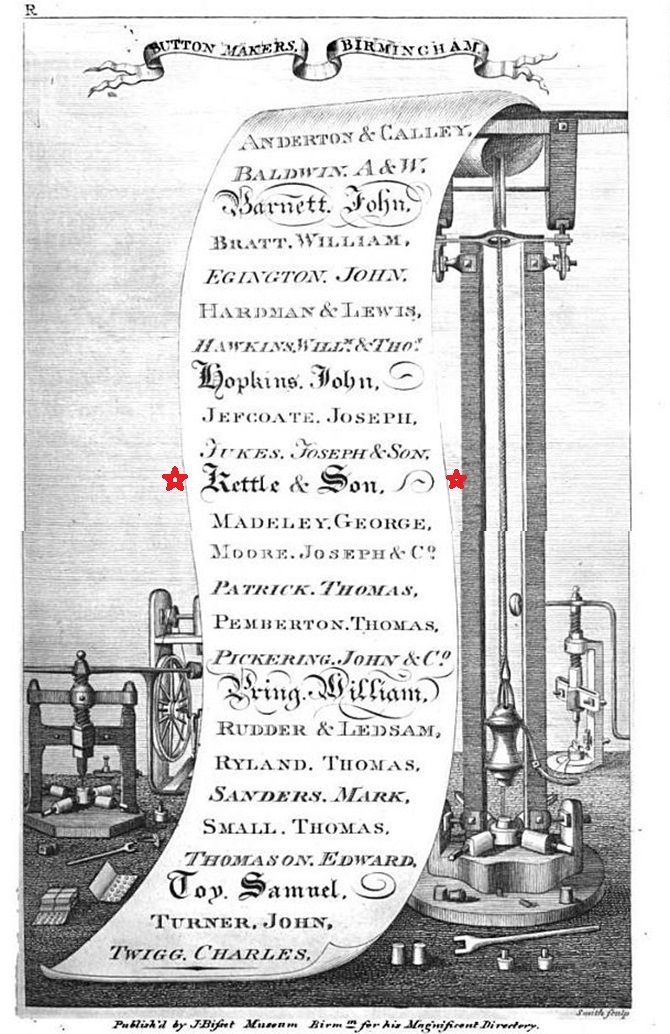
A document relating to Thomas perhaps helping to expand the company 1802.
Indenture of mortgage by way of demise from Thomas Kettle of Birmingham, button maker, to Henry Hill of Birmingham, painter, of a messuage, land and appurtenances in Suffolk Street, Birmingham. Parchment. Reference: MS 3388/Acc 1933-008/45
Date: 25 May 1802
A couple of documents relating to Thomas Kettle financial dealings re his acquisition of his father's company in 1811.
Bond from Thomas Kettle of Birmingham, button maker, to William Ashbee, brassfounder, and Eleazar Ashbee, gilt toymaker, both of Birmingham to secure the sum of £300. Paper. Reference: MS 3388/Acc 1933-008/48 Date: 24 June 1811
Assignment of mortgage from Henry Hill of Birmingham, painter, by the direction of Thomas kettle of Birmingham, button maker, to William Ashbee, brass founder, and Eleazar Ashbee, gilt toymaker, both of Birmingham, of a messuage, land and appurtenances in Suffolk Street, Birmingham. Parchment.
Reference: MS 3388/Acc 1933-008/47 Date: 24 June 1811.
One for a property expansion(or relocation) in 1817,
Assignment from Thomas Kettle of Birmingham, gilt toymaker, to Thomas Willmare of Birmingham, dealer in metals, of a messuage, manufactory and appurtenances in Suffolk Street, Birmingham, Subject to a mortgage from the said Thomas Kettle to William Ashbee and Eleazar Ashbee. Paper. Reference: MS 3388/Acc 1933-008/50 Date: 15 July 1817.In 1818 his address is, Kettle Thomas, 22 Suffolk-street
Another for a property expansion(or relocation) in 1825,
Assignment of mortgage from Eleazar Ashbee of Birmingham, gilt toy maker, by the direction of Thomas Kettle of Birmingham, button maker, to John Birch of Aston, gent., of a messuage, land and appurtenances in Suffolk Street, Birmingham. Parchment.
Reference: MS 3388/Acc 1933-008/51 Date: 28 June 1825And one in 1826
Lease for a year from Thomas Kettle of Birmingham, button maker and jeweller, and Samuel Twist of Birmingham, victualler, to Patience Robinson of Kidderminster, co. Worc., widow, of a messuage, manufactory and land with appurtenances in Suffolk Street, Birmingham. Parchment. Reference: MS 3388/Acc 1933-008/57 Date: 29 August 1826
Thomas died in 1929 and his wife Mary became owner, her eldest son, Francis Thomas(or Thomas Francis as both are used) remained with her.
This 1838 advert shows the previous expansions to adjoining properties 97,98 and 99 Suffolk street and Mary as owner.
The 1851 Census had Mary Kettle(she died 1852) as fundholder, son Francis Thomas a Gentleman. In 1858 Francis is listed as 98 and 99 Suffolk street. So Francis owned the business from 1852 till selling it to Hobson c. 1860 who is listed in 1861 as only 99 Suffolk street.
Sir Rupert Alfred Kettle (9 January 1817 6 October 1894) was an English barrister and county court judge, involved in arbitration of trade disputes he was Thomas and Mary's youngest child(born 1817).
He was the sole executor for his brother Francis, the last owner of the Kettle family business, which had been founded by Henri Quitel the French Huguenot emigre soon after 1685 and remained in the family until c. 1860, leaving a legacy of interesting tokens as a lasting memorial to almost 200 years of existence.
Thomas' son, Sir Rupert Alfred Kettle who had been knighted in 1879, acquired a coat of arms showing a beehive surrounded by a laurel wreath with the motto "Qui Tel", showing the family had not forgotten their roots. It can be translated as "Who is such a man as this?" -
It has been over 5 years since I purchased one of these, this is my latest one. It has a plain edge and is brass.
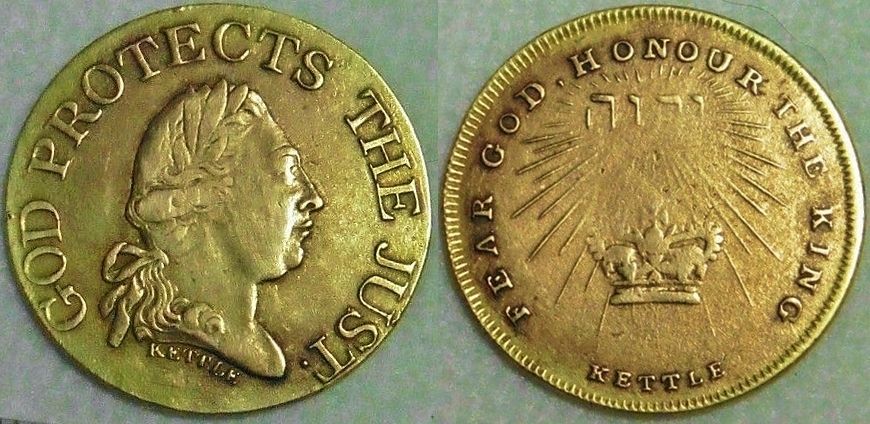
-
Nice acquisitions for your collection Clive, the one without a loop, though it is not at either end of the date range, is struck from different dies and is unsigned?
The wreaths on the reverses are very different.
I wonder what the story is about the change & then the change back?
-
Managed to acquire another in the series

Obv. . S . THOMAS . . APOSTOLVS .
Rev. DESCEDIT AD INFER. TERTIA . DIE RESURREX . A MORTVIS -
When I am searching(I always use google) I find often that the whole legend is a detriment to a search, as often only some of the legend is on any particular page, so I tend to use small segments as you said, I just used "Civitas Riponensis" and it popped up.
Found it listed in BHM#2957 AE R. WM R.
-
I will look further but found this,
"A commemoration medal was struck on the occasion, which was designed by Mr. Alderman Collinson, and so highly was the idea appreciated that the whole were disposed of immediately on their arrival, so that a second issue became necessary. The medal on the one side contained the arms of the house of Studley, with the words, "In commemoration of Frederick Oliver Earl de Grey attaining his majority, January 29, 1873." On the other side were the arms of Ripon, surmounted by the spurs and the words "Civitas Riponensis." A number of these were struck in silver, and six in silver, treble-gilt, were presented by the Mayor of Ripon to the Marquess, Marchioness, Earl de Grey, Lady Mary Vyner, Mr. H. F. C. Vyner, and Captain R. Vyner"
-
Cernin was the Plenipotentiary of Leopold I in Vienna, and like Cernin Leopold I used alchemists. One of these was the Augustinian monk Wenzel Seyler(or Wenceslaus), the comrade of Cernin's Matthew M. Bohem, in 1677 he changed a silver medal into gold in the presence of the Emperor, by dipping it into a liquid the upper part of the medal not being immersed remained silver. A clever trick!This is the medal
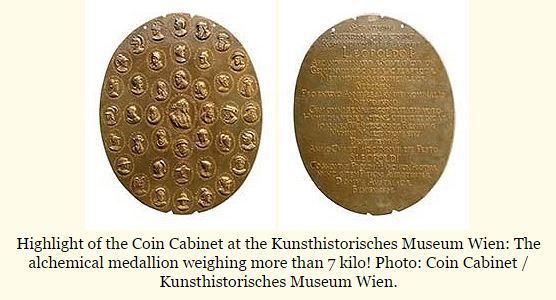 Leopold and Wife surrounded by his ancestors.To the Holiest, mightiest and most invincible Roman Emperor Leopold I, the thorough investigator of the secrets of nature, dedicates and offers this genuine sample of real and complete metallic transmutation, as a humble memorial sign of the annual feast day accompanied by the wish of blessings of any kind, a most humble servant of His Dignity, Highness and Majesty, most loyal John Wenceslas of Reinburg in the year of Christ 1677, on Saint Leopold's day, the surname of the former pious margrave of Austria, now the most gracious patron of the highest Austrian house
Leopold and Wife surrounded by his ancestors.To the Holiest, mightiest and most invincible Roman Emperor Leopold I, the thorough investigator of the secrets of nature, dedicates and offers this genuine sample of real and complete metallic transmutation, as a humble memorial sign of the annual feast day accompanied by the wish of blessings of any kind, a most humble servant of His Dignity, Highness and Majesty, most loyal John Wenceslas of Reinburg in the year of Christ 1677, on Saint Leopold's day, the surname of the former pious margrave of Austria, now the most gracious patron of the highest Austrian house -
In the numismatic collection of the National Museum in Prague is a cast gold 39 mm. medal with following inscription on the obverse EXC:mo. D: HVMBERTO. COMITI. CERNIN. D: BATRONO. 1.6.6.4. The Reverse: OFFERT. MATTHEo. M. BOHEM. CLIENS. - AVRVM HOC. CHIMICVM.This roughly translates as, either 1) Excellency, Lord Humbert Count Cernin, Master, this was struck in 1664 by Matthew M. Bohem, your servant, his offering of Chemical(Alchemy) Gold.or 2) Excellency, Lord Humbert Count Cernin, Master and Patron 1664. Matthew M. Bohem, your servant, offers this Chemical(Alchemy) Gold. Batrono is the problem word, if Patron is intended it should be Patrono, if struck it should be Battono.This cast medal has been shown to consist overall of 31% gold and 69% silver but the surface is 62.5% gold.Humprecht Czernin's Alchemist was Matthew M. Bohem he called himself, a comrade of the Augustinian monk Wenzel Seyler(another alchemist) who pretended to be able to turn tin into gold and undertook his transmutation before Leopold I.I have this unifaced cast medal of the obverse, which might be contemporary to the original or have been made at a later date( I would think no later than early 1800's). The reverse, which I first thought was machined flat, appears on closer examination to be ground flat by hand, which points to the earlier date of c.1664, as does the patina, but I am not sure.
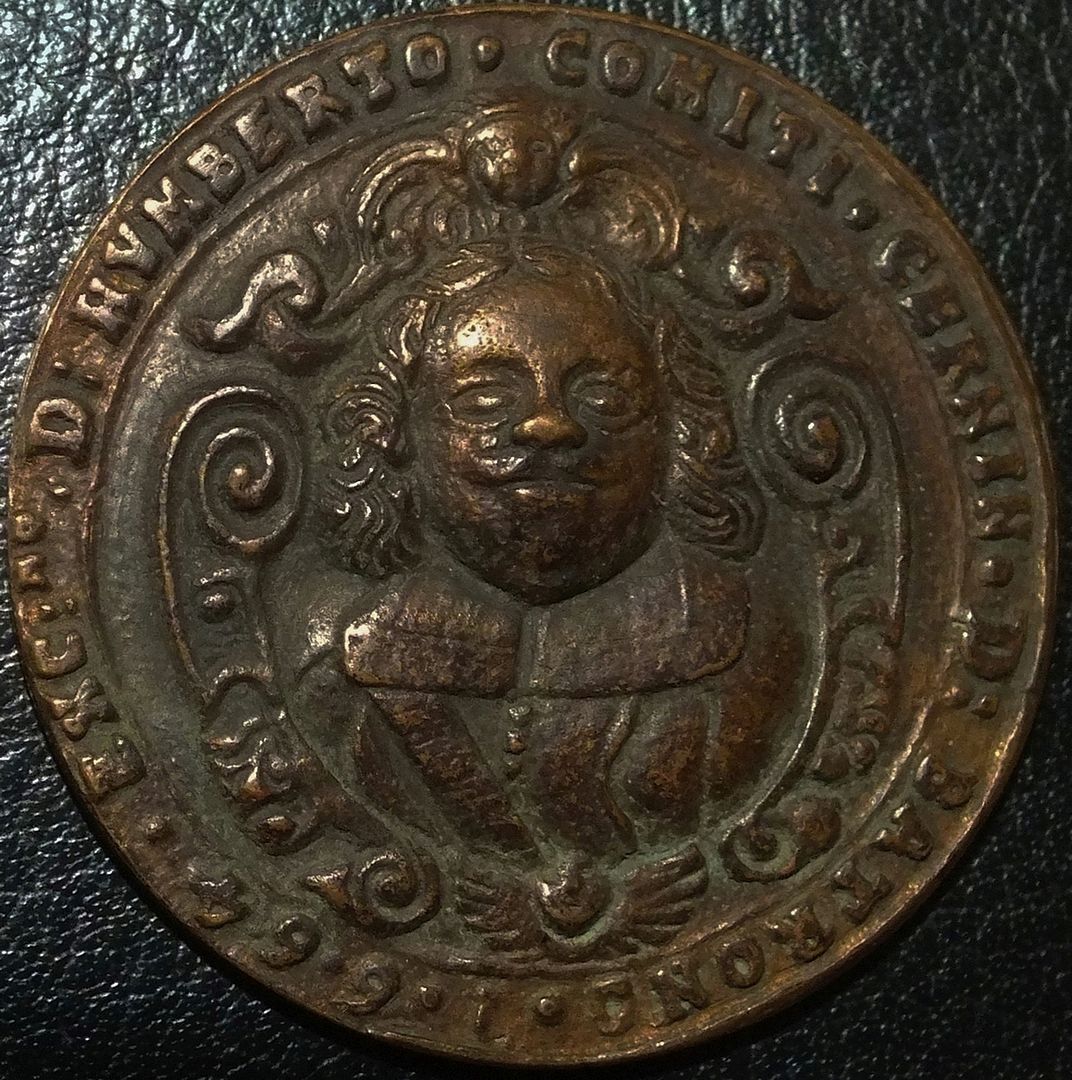 No references that I have found ascribe an engraver for the medal but the reverse of the gold medal is signed CM, the only two candidates for those initials and date are MAIER, CONRAD (Germ.). Mint-engraver and Medallist at Ulm, circ. 1663-1682. His issues are signed CM and CASPARO MOLO. Mint-engraver and Medallist at Rome, circ. 1625-1669.I believe that Conrad Maier is the most likely, being German.As for the Bohemian Count, this image will suffice for his titles.
No references that I have found ascribe an engraver for the medal but the reverse of the gold medal is signed CM, the only two candidates for those initials and date are MAIER, CONRAD (Germ.). Mint-engraver and Medallist at Ulm, circ. 1663-1682. His issues are signed CM and CASPARO MOLO. Mint-engraver and Medallist at Rome, circ. 1625-1669.I believe that Conrad Maier is the most likely, being German.As for the Bohemian Count, this image will suffice for his titles.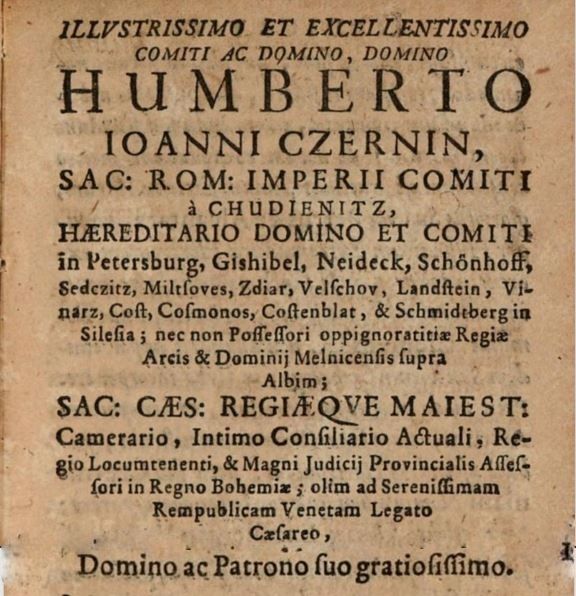 Jan Humprecht Czernin, visited Venice several times and was a patron and client there, too. Plenipotentiary of Leopold i, in 1663 healready owned 300 paintings and bought more; he lived on the Grand Canal for three years. In 1661 he had 19 works by Pietro Della Vecchia; 21 painters from the city worked for him, among whom were Liberi, Sebastiano Mazzoni, Loth, Girolamo Forabosco and Giovanni Battista Langetti. But apart from contemporary artists, Czernin also collected Giorgione, Titian and the Bassanos for his grandiose noble palace in Prague.
Jan Humprecht Czernin, visited Venice several times and was a patron and client there, too. Plenipotentiary of Leopold i, in 1663 healready owned 300 paintings and bought more; he lived on the Grand Canal for three years. In 1661 he had 19 works by Pietro Della Vecchia; 21 painters from the city worked for him, among whom were Liberi, Sebastiano Mazzoni, Loth, Girolamo Forabosco and Giovanni Battista Langetti. But apart from contemporary artists, Czernin also collected Giorgione, Titian and the Bassanos for his grandiose noble palace in Prague. -
The easiest way to post pictures is to use one of the free sites like "Photobucket" etc, then you just click on the blue header in your post, just below the orange "A" and the yellow "Smiley face" on the picture frame and post the direct link.

Please do not hesitate to ask for more advice if you need more help.
-
16-17TH CENTURY 5 MOSES MEDALS JEWISH JUDAICA RENAISSANCE HEBREW MEDALLIONS
They obviously copied the Zeus Ammon Ram's Horn type.

משה רבנו is Hebrew for Moses and is written on his collar.
-
Nice piece & the ones on the linked site show the begins of the die-crack, which on yours is more developed, very special.
-
The head facing left appears to be Zeus Ammon with ram's horn, as in this unrelated coin http://www.the-saleroom.com/en-gb/auction-catalogues/roma-numismatics-ltd/catalogue-id-srro10003/lot-73da9a99-2921-426d-a0a6-a5bc00ff8037
The inscription is Aramaic, Semitic, etc.
Sorry that is as much as I know, hope it helps.
-
From the larger picture, which shows many more letters affected(especially the M) it does look more like excessive die wear and/or improper die annealing causing the lettering to be thick and mushy, making some letters appear to be doubled, others as if over struck.
-
4 of the A's appear to be struck over O's, also the R. Almost like a faulty punch was used, do they still use punches somewhere in the die making process?
Seems weird but what other explanation could there be?
-
Been to many pubs, perhaps too many, but a M. of G. never had the pleasure

Building is still there, private accommodation I think.
Thanks for your interest TDP.
-
Great idea, nice item!
-
A later Marquis of Granby was MP for Stamford, 1837-1852 and in the Highstreet St. Martin's Stamford was a "Marquis of Granby" pub dating from early 18th century.The name of the Inn had been changed to "The Waggon and Horses" circa 1800 but had been changed back to "Marquis of Granby" in 1846 by John Gardner but records show that the landlord in 1855 was a G. Bleet. Could this be who the initials G. B. under the bust are for?If so that gives a date for the tokens, circa 1850, here is an image of the old pub.

-
A later Marquis of Granby was MP for Stamford, 1837-1852 and in the Highstreet St. Martin's Stamford was a "Marquis of Granby" pub dating from early 18th century.The name of the Inn had been changed to "The Waggon and Horses" circa 1800 but had been changed back to "Marquis of Granby" in 1846 by John Gardner but records show that the landlord in 1855 was a G. Bleet. Could this be who the initials G. B. under the bust are for?If so that gives a date for the tokens, circa 1850, here is an image of the old pub.



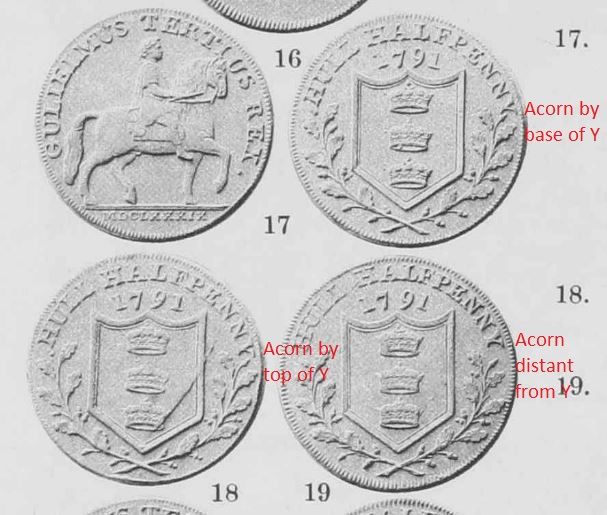
The Kettle Family of Die Sinkers
in Exonumia (Tokens, Medals, etc) Forums
Posted
The only thing I know for sure is that the censuses show many family members at the same address, or adjacent addresses, and some other relatives & the odd female servant(F.S.)
They had large families and they do appear to have lived and worked at the same premises or at least premises side by side.
Considering all the different types of items they made it seems a shame that the tokens seem to be the only things that survive that can be attributed to them. On the plus side, without the tokens they would seem almost not to have existed.
I would dearly love to find anything, besides the tokens, with the Kettle name on it.